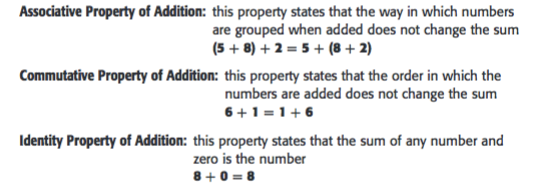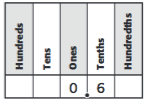PSSA Math Prep
-
Thank you for visiting this page to help prepare your child more for the PSSAs. I have been preparing the class to do their best on the test. I have listed the skills we have covered in math class. I encourage you to review these materials with your child.
Study Island and ST Math
Your child can always login to Study Island and do a lesson and questions that are similar to the PSSAs. You can also have your child practice on ST Math We have done this in class and your child has done it for homework as well. :)
Place Value
We worked on taking numbers that were several digits long and figuring out the place value and the different notations of the numbers.
Expanded Form: The representation of a number as a sum that shows the value of each digit.
example: 1,528= 1,000+ 500+ 20+ 8
Standard Form: This is the "usual way" of writing a number with only digits and no words.
example: 10,458
Written Form: This representation has words and no digits.
example: four hundred fifty-two is written form for 452
Adding and Subtracting Whole Numbers
Your child should be able to add and subtract multi-digit numbers with regrouping. Please practice this skill at home.
We also worked on identifying properties of addition.
Fractions
We have worked with fractions for several chapters. Your child should be able to tell you the top part of a fraction is the numerator and the bottom part is the denominator. We also worked on adding, subtracting and multiplying like fractions.
We also worked with Greatest Common Factor (GCF) and Least Common Multiple (LCM). Again this concept of factor and multiple can be challenging for some. Please review it at home.
Equivalent Fractions are fractions that represent the same number.
Example: 3/4 is equal to 6/8
Simplest Form is a fraction whose numerator and denominator have no common factor other than one. Please practice getting fractions into simplest form.
Mixed Number is a number named by a whole number and a fraction.
Improper Fractions are fractions when the numerator is greater than the denominator. We took the improper fractions and made them into whole numbers.
Decimals:
Decimals are numbers that have one or more digits to the right of the decimal point.

Measurement:
We spent time in math and science class learning about Customary/Standard and Metric measurement. We worked with the basic formulas and converted them. Your child will be given the formulas, but will need to make conversions.
Example: 1 foot = 12 inches
How many inches are in 4 feet? Your child will need to come up with the answer from what he/she is given.
Area and Perimeter:
Your child has been working on perimeter and area throughout the year with our morning words and lessons. You child should know the difference between area and perimeter.
*Area is the number of square units that it takes to FILL IN the region or plane figure. The area of a rectangle is length x width. The area of a square is side x side.
*Perimeter is the distance around the shape or region.
Geometry:
Geometry is a fun unit to explore. Your child has been introduced to shapes since kindergarten and should know that a circle has 0 sides, a triangle has 3 sides, a quadrilateral has 4 sides, pentagon has 5, hexagon has 6, and so on. We also discussed how each of these shapes has angles as well. The angles can be classified into acute, obtuse or right/square angles.
An acute angle has a measurement of greater than 0 and less than 90 degrees. An obtuse angle has a measurement great than 90 degrees and less than 180 degrees. A right or square angle has exactly 90 degrees.
We also explored rays, line segments, lines and specific types of lines.

